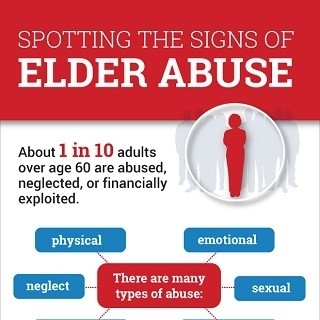Elder abuse is a growing concern, with 1 out of 10 adults age 60 and older reporting some form of abuse in the U.S. In this challenging time of increased social isolation, family stress, and limited resources due to the pandemic, there is a chance that elder abuse is increasing. What can we do about this? We can learn more about elder abuse and watch for signs of it in older people.
 Spotting the Signs of Elder Abuse NIH Infographic
Spotting the Signs of Elder Abuse NIH Infographic
Family members, including adult children and spouses, are often the perpetrators.
- The most common forms of abuse are financial, physical, and emotional.
- Disabled, frail, and isolated older adults are at higher risk for abuse.
- Many elders are too fearful or ashamed to report abuse.
- For every report of abuse, five cases are estimated to go unreported.
Other Types of Abuse
- Sexual
- Neglect or abandonment
- Healthcare Fraud
Read more about these types of abuse.
What to Be Aware Of
Abuse victims may isolate themselves and act withdrawn, look messy, look under or over-medicated, act confused or agitated, and display signs of trauma. Find out more about signs in Facts About Elder Abuse.
Caregivers Need Support Too
Caregivers may be feeling overwhelmed and stressed with the burdens of caregiving. VisionAware provides many resources to help caregivers of people with vision loss. Be sure to read our post on Caregiving Challenges During the Holiday Season. NIA (National Institute on Aging) also has useful tips on reducing caregiver stress.
Increase in Abuse During the Pandemic and the Holiday Season
The pandemic has greatly exacerbated the problem of elder abuse, especially financial abuse. Drs. Han and Mosquesda report a massive increase in many forms of abuse and have developed an Abuse, Intervention, and Prevention Model designed to mitigate the risks. Isolation increases the risk for abuse. According to Han and Mosqueda, “social isolation has been established as one of the strongest predictors of elder abuse.” (PBS, June 2020)
During the holidays, it is particularly important to be aware of the signs of abuse. Dr. Kathleen Wilber, at the University of Southern California (USC), has been working on pilot programs to stop abuse and has this to say, “Perhaps the most meaningful gift you can give an older adult, and your future self, is attention to their health and safety… not just during the holidays but all the days of the year.” (The Conversation, December, 2019)
The National Institute on Aging encourages us to help spread the word about recognizing the signs of elder abuse. Download a printable copy of the NIH infographic on spotting elder abuse.
Reporting and Referral
If you or someone you are concerned about is experiencing possible abuse, there are actions you can take:
- Call the police or 911 immediately if someone you know is in immediate, life-threatening danger.
- Consult the Facts About Elder Abuse for more recommendations.
Sources
National Center on Elder Abuse
National Institute on Aging
Elder Abuse and Ageism During COVID-19
Elder Abuse Appears to be Climbing During the Pandemic